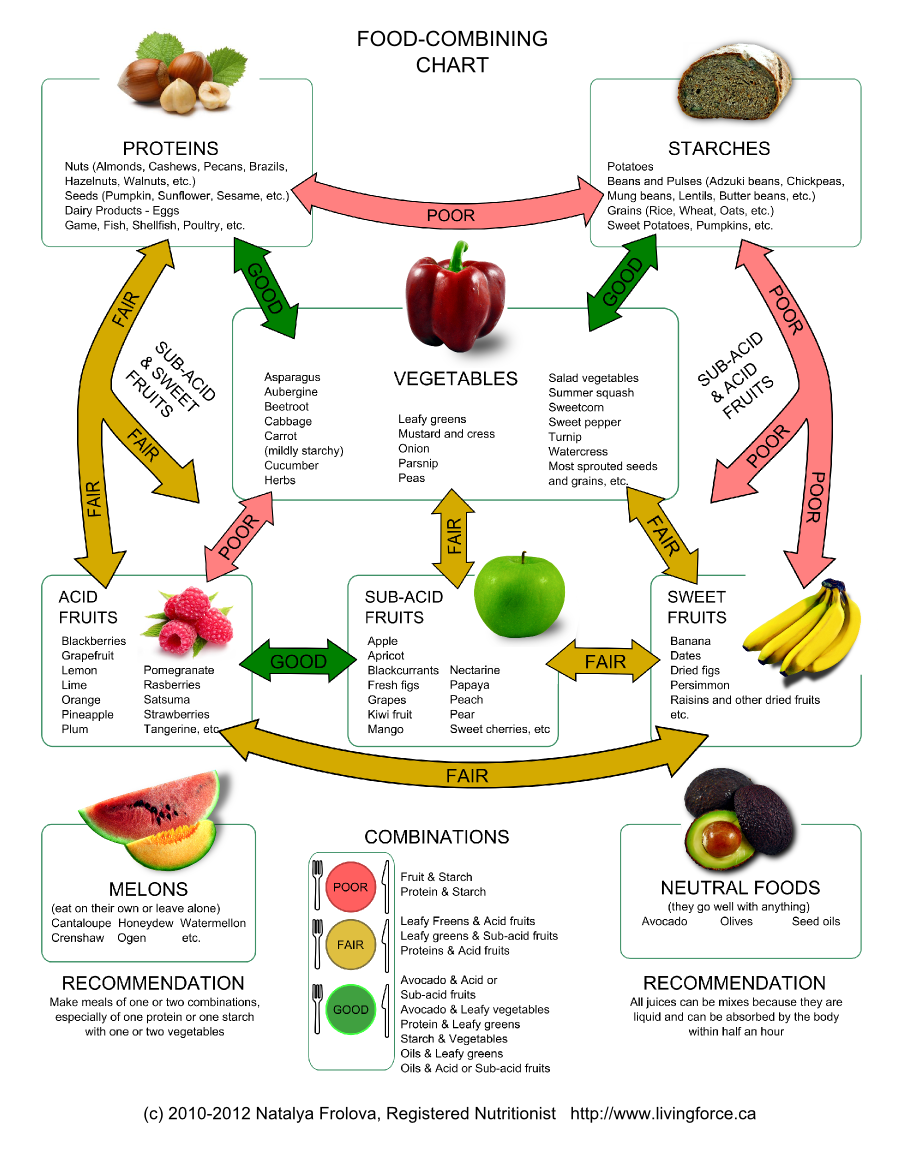Does Food Combining Work? The Hay Diet
Food Combining Not a New Idea
 Food combining is by no means a new idea in the nutrition field. The Hay Diet, developed by Dr. William Howard Hay in the 1920’s, is a plan where you separate your food into groups. These groups would be acidic, alkaline and neutral.
Food combining is by no means a new idea in the nutrition field. The Hay Diet, developed by Dr. William Howard Hay in the 1920’s, is a plan where you separate your food into groups. These groups would be acidic, alkaline and neutral.
“Any carbohydrate foods require alkaline conditions for their complete digestion, so must not be combined with acids of any kind, as sour fruits, because the acid will neutralize. Neither should these be combined with a protein of concentrated sort as these protein foods will excite too much hydrochloric acid during their stomach digestion.” – William Hay, How to Always Be Well
Hay designed his nutrition plan to treat symptoms connected to obesity. He believed changing eating habits rather than taking drugs, was better in the treatment of cardiac disease, kidney disease, and kidney disorders. He felt that improperly combining food is a significant factor in many stomach issues such as gas, heartburn, and general upset stomach. All of these symptoms are the result of poor digestion, which also contributes to malnutrition, even when you are eating healthy food.
Primary Focuses of Food Combining
The two top rules of food combining are: no proteins and starches within the same meal; and do not have fruit and vegetables at the same meal.
Proteins and starches must be kept separate because they counteract each other which inhibits them from getting digested properly. The way to ensure healthy digestion is to separate them by 2 to 3 hours. When consuming a starch, wait 2 hours before having any protein. However, when ingesting protein first, you need to wait 3 full hours before consuming a starch.
Hay observed that fruits and vegetables supply an alkaline end-product when completely digested while processed foods become highly acidic after digestion. His theories went on to include food-combining declaring incorrect combinations of foods even caused alkaline foods to convert to acidic ones after digestion. Hay upheld that the answer was to eat proteins at one meal and carbohydrates at another.
The Hay diet is centered on three categories, Proteins, Starches, and Neutral Foods. Foods in the Proteins and Neutral category may be combined, and foods in the Neutral category may be combined with Starches. However, the combination of Starches and Proteins should always be avoided.
Here are Hay’s Combining categories (3)
Protein Category:
- Meat (Organic is preferable), poultry, fish, eggs, and dairy products including milk, cheese, and yogurt. Milk should be avoided with meat, but combines well with fruit.
- Most fruits – listed in this category are apple, apricot, berries, cherry, currants, gooseberry, grapefruit, grapes, kiwi, lemon, lime, lychee, mango, nectarines, oranges, passionfruit, pears pineapples, prunes, raspberries, strawberries, guava and tangerines.
- Beans which include lentils, pinto beans, kidney beans, soy beans, garbanzo beans (chickpeas), haricot beans, and lima beans.
- Melons, however, they must be consumed separately.
- Red wine, white wine, and cider.
Neutral Category:
- Vegetables except those listed in the Starch category
- Fats including butter, cream, egg yolks, and olive oil
- Nuts except peanuts.
- Whisky and Gin
Starch Category:
- Cereal, rice, and products and whole grains (wheat, oats, corn, and barley)
- Vegetables higher in starch such as potatoes, sweet potatoes, pumpkins, and Jerusalem artichokes.
- Sweeter fruits such as raisins, dates, figs, sweet grapes, and ripe bananas. Overripe fruit is not allowed because of the high sugar content
- Beer and ale.
The thought behind this eating plan is that diseases are a matter of removing toxins just as much as it is about eating proper foods. Removing toxins, however, is reliant on a robust digestive system. The appropriate food combinations take into account the intricacy of digestion of each food, and it ensures that it goes through the entire length of your digestive system with ease.
The When and What of Eating
Dr Wayne Pickering, a naturopath from Florida, is probably best known for promoting the importance of food combining. He suggests the amount and sequencing of the foods you eat also makes a difference.
He recommends the following eating schedule:
- Morning meal: The smallest concentrated foods, in the largest amount. Ideal choice: fruits
- Mid-day meal: More complex foods, but in lesser amounts than your morning meal. Ideal choice: starchy carbs
- Evening meal: The highest concentrated foods, but in the smallest amount. Ideal choice: protein
However…
Not everyone agrees with Hay’s food combining theory of separating proteins from carbohydrates. In 1935, Stewart Baxter showed that the pancreas secretes digestion enzymes simultaneously regardless of whether the food eaten is carbohydrates or protein, contrary to one of the central suppositions of the diet.(2) In fact, it is now known that our stomach is acid based and our intestines are alkaline based meaning that both proteins and carbohydrates can be digested simultaneously.
The theory that carbohydrate and protein rich foods should be eaten separately, has been refuted since it ignores the fact that carbohydrate rich foods contain significant amounts of protein. Also, eating protein separately from carbohydrates tends to cause the body to burn the protein as an energy source rather than to build muscle.(1)
Also, the Hay diet doesn’t include portion sizes; and portion control is an important part of sustaining a healthy weight. Additionally, people can fail to get enough of the vitamins and nutrients needed by restricting food groups to once per day. Finally, the Hay diet appears to help people lose weight not so much because of the food combining theory, but because they are more conscious of what they eat.
Important Consideration
While consuming fruits and vegetables will help with constipation, people shouldn’t rely on the Hay diet to treat a condition such as heart disease, arthritis, allergies, and asthma. People diagnosed with conditions might need medication and should consult their doctor before undertaking the Hay diet or any other weight-loss plan.
Want to Learn More About Healthy Nutrition?
Check out our Certified Sports Nutrition Program. Our innovative fitness nutrition certificate program integrates the knowledge and expertise of both Infofit and the Cory Holly Institute (CHI), offering certification that is internationally recognized and respected.
Consisting of ten instructive online learning modules that took more than a decade to research and develop, this comprehensive distance learning education program certifies each student as a Certified Sports Nutrition Advisor (CSNA).
Cathie Glennon – BCRPA SFL, CSNA
References
- Bender, David A. (2009).A dictionary of food and nutrition (3rd ed.). Oxford: Oxford University Press.
- Cardwell, Glenn,The Skeptic, Nutrition: Food Combining, Vol 16, No 2
- https://www.diet.com/g/hay-diet
Resources
- Hay, William Howard.Health via Food. Sun-Diet Health Service, 1929
- https://www.nutriplanet.org/2014/02/combining-foods/
- https://www.diet.com/g/hay-diet
- https://en.wikipedia.org/wiki/Hay_diet
- https://articles.mercola.com/sites/articles/archive/2013/10/27/food-combining.aspx
-
 Sports Performance and Fitness Nutrition$2,094.75 – $3,144.75
Sports Performance and Fitness Nutrition$2,094.75 – $3,144.75 -
 Back to School Nutrition Podcast$15.75
Back to School Nutrition Podcast$15.75

